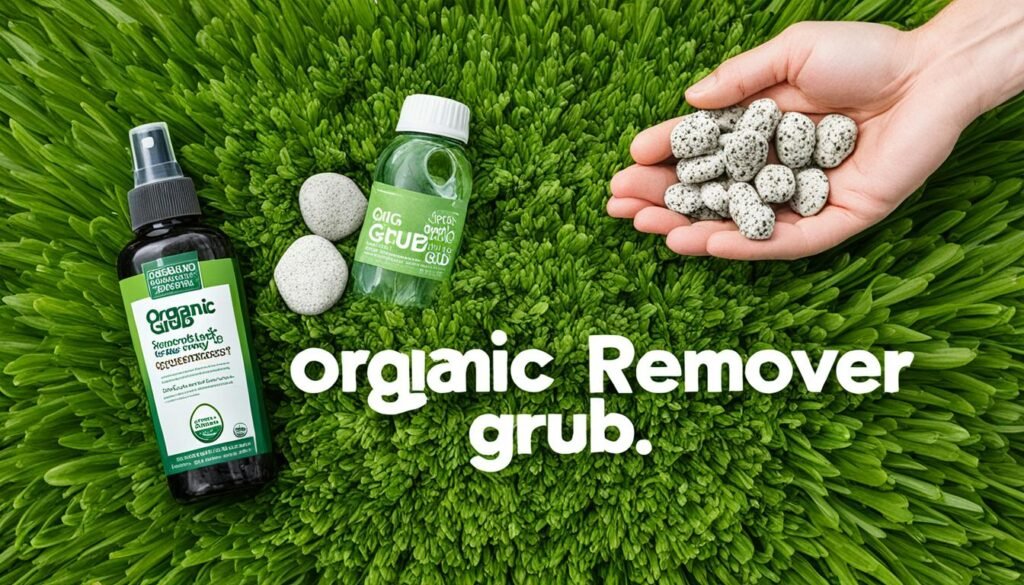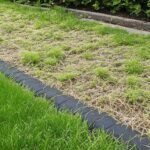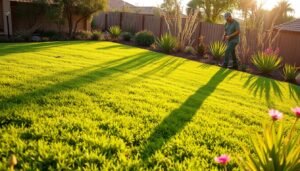
Lawn care is essential to maintain the lush green beauty of your yard. However, did you know that a single grub can destroy up to 10 square feet of grass in just a few days? That’s right – these small, white larvae can quickly turn your once vibrant lawn into a patchy, brown mess. But fear not, because with the right knowledge and effective grub removal techniques, you can save your lawn from the devastating effects of these pesky invaders.
Key Takeaways:
- Grubs can cause significant damage to your lawn, leading to brown patches and weakened grass roots.
- Immediate action is crucial for effective grub control and removal.
- Natural methods can help eliminate grubs while minimizing the use of synthetic chemicals.
- Maintaining a healthy lawn with proper care practices can prevent grub infestations.
- Regular monitoring and applying preventive measures are key to long-term grub control.
Natural Grub Removal Methods and Prevention Strategies
If you prefer to use natural or organic solutions for grub removal, there are several effective methods available that can help eliminate grubs and prevent future infestations without relying on synthetic chemicals. Not only are these methods environmentally friendly, but they also promote the overall health of your lawn.
Here are some natural grub removal methods and prevention strategies:
1. Nematodes:
Beneficial nematodes, such as Steinernema feltiae, are microscopic organisms that can be applied to the soil to control grub populations. These nematodes infect and kill grubs while reproducing within their bodies. This natural approach targets the grubs specifically, minimizing harm to beneficial insects and organisms.
2. Milky Spore Disease:
Milky spore disease, caused by the bacterium Bacillus popilliae, is an effective way to control Japanese beetle grubs. This disease is fatal to grubs but harmless to humans, pets, and other beneficial insects. Once applied to the soil, the spores remain active for years, providing long-term protection against future infestations.
3. Manual Removal:
If you have a small lawn or a localized grub infestation, manual removal can be an effective option. Use a trowel or shovel to dig up the affected areas and physically remove the grubs. Be sure to dispose of the grubs properly to prevent reinfestation.
4. Healthy Lawn Practices:
Maintaining a healthy lawn is essential for preventing grub infestations. Implement the following practices to create an environment that is less attractive to grubs:
- Proper watering: Water deeply and infrequently to encourage deep root growth and discourage grubs from congregating near the surface.
- Mowing height: Keep your lawn at the recommended height for your grass type. Longer grass provides shade and helps prevent grub infestations.
- Aerate: Regularly aerate your lawn to improve soil drainage and reduce compaction, creating a healthier turf.
- Fertilize appropriately: Apply organic fertilizers that promote strong root growth and overall lawn health. Avoid excessive nitrogen, as it can attract grubs.
- Overseed: Overseeding helps thicken your lawn, minimizing bare spots that attract grubs.
By incorporating these natural grub removal methods and prevention strategies into your lawn care routine, you can maintain a lush, grub-free lawn without relying on synthetic insecticides.

| Natural Grub Removal Methods | Effectiveness | Difficulty |
|---|---|---|
| Nematodes | High | Medium |
| Milky Spore Disease | High | Low |
| Manual Removal | Low | High |
Maintaining a Healthy Lawn to Prevent Grub Infestations
Preventing grub infestations and maintaining a healthy, vibrant lawn is essential for every homeowner. By implementing best lawn care practices, you can effectively control grubs and minimize their damage. Here are some strategies to help you prevent grub infestations:
Regularly mow your lawn at the recommended height to keep it strong and resilient. By maintaining the proper mowing height, you create a dense and healthy turf that is less attractive to grubs.
Ensure your lawn receives adequate water, but avoid overwatering. Grubs thrive in moist conditions, so a proper watering schedule is crucial. Water deeply and infrequently to encourage deep root growth and discourage grub activity.
Fertilize your lawn appropriately using a balanced slow-release fertilizer. A well-fertilized lawn promotes strong root development and enables the grass to withstand grub feeding. However, be cautious not to over-fertilize, as excess nitrogen can attract grubs.
Overseeding your lawn with resistant grass species is another effective strategy. Research and choose grass varieties that are known to be resistant to grubs. These hardy grass types will not only enhance the overall health of your lawn but also deter grub infestations.
Incorporating these best lawn care practices into your routine maintenance will promote a healthier, more robust lawn and minimize the risk of grub infestations. By maintaining a strong turf, you can enjoy a lush and beautiful lawn all year round.






No comment yet, add your voice below!